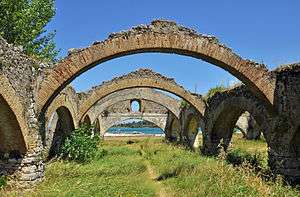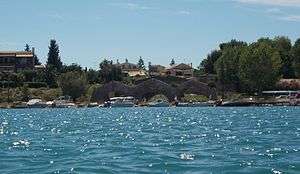Venetian arsenal, Gouvia

The Venetian arsenal at Gouvia is a shipyard built by the Venetians during their rule of Corfu on the west side of what used to be called Govino Bay,[1] the current location of the modern village of Gouvia. The remains of the old arsenal still exist at the Bay of Gouvia,[2] and are located approximately 8 km from Corfu city.[3] The ruins are behind the modern marina of the port of Gouvia and are separated from it by an iron fence.[4][5]
The Venetians used the bay as a port and their arsenal was built near the water.[6] The Venetian shipyard features three arched docks which were used to service their two fleets which were stationed in Corfu.[7] The columns, walls and arches of the arsenal survive almost intact but the roof is missing.[8]

The use of the arsenal was officially discontinued when the Treaty of Campo Formio, which was signed on 18 October 1798, signalled the end of the Venetian Republic. Admiral Ushakov landed his troops at the site of the arsenal and created a military camp there during the Siege of Corfu in 1798. The arsenal also functioned as a base for the French in 1917–1918.[9]
Historical background

Located near the mouth of the Adriatic Sea, Corfu was a very strategic location for Venice and the Venetians built extensive fortifications to defend the island against incursions. The island was also at the centre of their naval operations in the Levant. As part of their defence plans the Venetians stationed two squadrons in Corfu, one of twenty five galleys, the other of twelve heavy sailing ships. Two Venetian Vice Admirals oversaw the naval operations in Corfu, one for each squadron.[10]

In the aftermath of the second great siege of Corfu by the Ottomans in 1716,[11][12] the Venetians, as part of their reinforcement of the fortifications of Corfu, built the arsenal to service their ships and also stationed their galleys at Govino Bay.[13][14] The arsenal was also used as storage for the Venetian ships.[15]
The shipyard at Gouvia was part of a network of Venetian arsenals and naval stations in Greece, including shipyards in the Aegean Sea, Epirus, the Peloponnese, the Kingdom of Candia (modern Crete) and even Venice itself. Aside from Corfu, such locations in Greece included Methoni, Koroni, Chalkis, Preveza, Chania and Heraklion.[16]
The Venetians built the Gouvia arsenal in a strategic location well-suited to ship repairs as it was near a forested area and high quality wood was plentiful and easily available for ship maintenance.[14]

The keystone of the gate at the entrance to the shipyard bears the inscription:
ZBM
ANNO
MDCCL
XXVIII
where "ZBM" are probably the initials of one of the ship captains who constructed the arsenal and added their coat of arms and initials to the buildings,[11] and the year is 1778.[8][11]
The practice of the Venetian captains, who participated in the construction of the arsenal, to inscribe the buildings with their initials and coats of arms, had been documented in the late-18th-century writings of French consul to Corfu Saint-Sauveur.[11]
The arsenal at Gouvia was supposed to be used for ship repairs during the winter after each fleet had returned from their yearly campaign during peacetime.[10][14]
However, the Venetian Senate became alarmed at the prospect of an arsenal in proximity to Venice which could potentially compete with the central arsenal and in order to protect the operations of their local naval facilities, the Senate opted to limit the kind of repair activities undertaken at the Corfu shipyard.[14]
Consequently, the shipyard operations at Gouvia were restricted to basic maintenance such as cleaning and caulking;[10][14] many captains, instead of repairing their damaged ships at the arsenal, chose to sink them.[10]

As time went on, the number of ships being serviced at the location declined,[10] and any further use was officially discontinued with the Treaty of Campo Formio, which was signed on 18 October 1798, marking the end of the Venetian Republic and with it the end of the Venetian period of Corfu, which had lasted for over 400 years.[17]
The surviving arches of the structure have been described as "beautifully boned",[17] "strong" and "impressive",[11] "almost surreal",[4] and "a striking collection of skeletal arches".[18]
Conservation and restoration proposals
Spyridon Spyrou, the regional director of the Ionian Islands, submitted a plan to the Greek Ministry of Culture for the conservation and development of the ruins. The proposal includes the plans of the landmark which have been developed by the polytechnic of Bari which consist of photographs, historical analysis of the structure and diagrams. The study was funded by the European Union regional funding programme Interreg III Greece-Italy.[19]

The application of the director, describes the current state of ruin and neglect of the arsenal which invites negative comments by visitors to the area, given the historical importance of the monument to the Ionian Islands and Greece, and suggests to the ministry the restoration of its walls and roof and its conversion to a Museum of the Sea. The application also includes mention of the support of the proposal by Mrs Rigakos, the director of the 21st Ephorate of Byzantine Antiquities of Greece, who approved of the idea calling it "very good and indispensable".[20]
The ministry, in response to the application, has expressed interest in the idea,[21] and has described the arsenal as a monument of high importance for the Venetian period of Corfu. The Ministry also explained that the arsenal is not yet eligible for the special government programme which provides funds for the development of the Greek provinces but suggested a joint funding project with the participation of the Ionian Islands directorate. The ministry also proposed that the gate of the monument be immediately repaired and structurally braced for safety reasons, suggesting the participation of the 21st Ephorate in any future repair works.[20]
References
| Wikimedia Commons has media related to Venetian arsenal, Gouvia. |
- ↑ Great Britain. Hydrographic Dept (1861). The Adriatic Pilot. p. 225.
- ↑ Saturday Review. Saturday Review Associates. 1962. p. 30.
- ↑ James Lawrence McKnight (1965). Admiral Ushakov and the Ionian Republic: the genesis of Russia's first Balkan satellite. University of Wisconsin--Madison. p. 115.
- 1 2 Nick Edwards; John Gill (2003). The Ionian Islands. Rough Guides. p. 82. ISBN 978-1-84353-067-1.
- ↑ Dominique Auzias; Jean-Paul Labourdette; Collectif (20 September 2012). Îles Ioniennes (avec cartes et avis des lecteurs). Petit Futé. p. 62. ISBN 978-2-7469-6290-3.
- ↑ Anne Midgette (1999). Greek Islands. Nelles Verlag. p. 216. ISBN 978-3-88618-024-0.
- ↑ Raymond Matton (1960). Corfou. l'Institut français d'Athènes. pp. 92, 219.
Au cours de l'hiver on procédait à l'entretien ou à la réparation des navires dans le port de Govino, où les Vénitiens avaient installé un arsenal après le siège en 1716. ... tandis que les Grecs appellent le lieu Gouvia. [...] ...the very closed character of this small bay surrounded by walls and bordered by buildings with three berths for galleys.
- 1 2 Nondas Stamatopoulos (1993). Old Corfu: history and culture. N. Stamatopoulos. p. 167.
- ↑ Greece. 1962. p. 851.
along the bay of Gouvia (fine remains of a Venetian arsenal, post-1716; former vaulted berths for galleys; French base in 1917–1918)
- 1 2 3 4 5 Frank Giles; Spiro Flamburiari; Fritz Von der Schulenburg (1 September 1994). Corfu: the garden isle. J. Murray in association with the Hellenic Group of Companies Ltd. p. 40. ISBN 978-1-55859-845-4.
They were supposed to undertake one campaign a year in peacetime, being repaired in winter at the Gouvia Arsenal. But activity there was confined to careening and basic maintenance; and the number of ships steadily diminished, with many captains scuttling their unseaworthy vessels, while others went off on commercial cruises.
- 1 2 3 4 5 The Gentleman's Magazine. A. Dodd and A. Smith. 1967. p. 57.
The strong arches of that naval establishment seem impressive even to-day; but their career of usefulness was short. The arsenal, in its present form, was not founded till after the great Turkish invasion of 1716, and I copied down on the spot two even later dates from the ruined buildings hard by. One states laconically :ZBM ANNO MDCCL XXVIII. This inscription doubtless preserves the initials of some Venetian "captain of the ships," for those officials built all the works at Govino, and their desire to immortalise themselves by putting their names and escutcheons on the buildings is specially mentioned by the French consul Saint-Sauveur at the end of the eighteenth century.
- ↑ The Gentleman's Magazine-via Internet Archive: "The Gentleman's Magazine Volume CCXCVII. JULY TO DECEMBER 1904". 297. The Gentleman's Magazine. 1904. p. 57.
- ↑ Elizabeth Mary Leveson-Gower Grosvenor Westminster (2d marchioness of) (1842). Narrative of a Yacht Voyage in the Mediterranean: During 1840–41. J. Murray. p. 250.
- 1 2 3 4 5 Lord Michael Pratt (1978). Britain's Greek Empire: Reflections on the History of the Ionian Islands from the Fall of Byzantium. Rex Collings. pp. 36–37. ISBN 978-0-86036-025-4.
They were supposed to undertake one campaign a year in peacetime, being repaired in winter at the Gouvia Arsenal. [...] ...was ideally placed, with forests on the mainland affording excellent timber for shipbuilding, but the Senate, anxious about its own Arsenal, confined activity at Gouvia to careening and basic maintenance.
- ↑ Larousse Harrap Publishers (January 1989). Greece. Harrap. p. 376. ISBN 978-0-245-54272-5.
5mls (8km): Gouvia where the Venetians stored or repaired their galleys in vaulted boathouses
- ↑ Kōstas Damianidēs (1997). Nautikḗ parádosē sto Aigaío: tarsanádes kai skariá. Hypourgeio Aigaiou. p. 26.
ή τεχνίτες εργάζονται όμως και στα βενετσιάνικα ναυπηγεία και τους ναυσταθμους στο Αιγαίο (Χανιά, Ηράκλειο, Μεθώνη, Κορώνη, Χαλκίδα, Πρέβεζα και Κέρκυρα) όπως επίσης και στο ναύσταθμο της ίδιας της Βενετίας
- 1 2 John Freely (28 April 2008). The Ionian Islands: Corfu, Cephalonia, Ithaka and Beyond. I. B. Tauris, Limited. p. 68. ISBN 978-1-84511-696-5.
- ↑ AA Staff; Gerry Crawshaw; Martin Trelawny (15 January 2007). Essential Corfu. Automobile Association. p. 134. ISBN 978-0-7495-4948-0.
At the road end are the remains of a Venetian 'arsenal' or boat-repair yard, a striking collection of skeletal arches with ...
- ↑ Ανάδειξη στα Βενετσιάνικα ναυπηγεία στη Κέρκυρα (in Greek). In On Press Agency.
- 1 2 Πρόταση του Περιφερειάρχη Ι.Ν. προς τον Υπουργό Πολιτισμού για τα ενετικά ναυπηγεία Γουβιών, στην Κέρκυρα: Ανασύσταση της αρχικής δομής του Ναυπηγείου και της στέγης του και χρήση του ως Μουσείου της Θάλασσας (in Greek). ΠΕΡΙΦΕΡΕΙΑ ΙΟΝΙΩΝ ΝΗΣΩΝ - ΠΕΡΙΦΕΡΕΙΑΡΧΗΣ.
- ↑ Αναζήτηση ΥΠΠΟ (in Greek). Corfu Press.
21. Πρόταση Σπύρου στο ΥΠΠΟ για την ανάδειξη των ενετικών ναυπηγείων (ΕΙΔΗΣΕΙΣ/Πολιτική) Ενδιαφέρουσα βρίσκει το Υπουργείο Πολιτισμού την πρόταση του Περιφερειάρχη Ιονίων Νήσων, Σπ. Σπύρου, για τη στερέωση και ανάδειξη των ενετικών ναυπηγείων Γουβιών, στην Κέρκυρα, όπως αναφέρει η ΠΙΝ σε ...
Coordinates: 39°39′8.86″N 19°50′48.64″E / 39.6524611°N 19.8468444°E